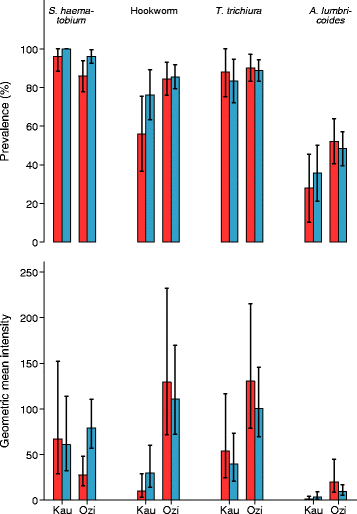Schistosoma haematobium and soil-transmitted Helminths in Tana Delta District of Kenya: infection and morbidity patterns in primary schoolchildren from two isolated villages
- PMID: 26842961
- PMCID: PMC4739089
- DOI: 10.1186/s12879-016-1387-4
Schistosoma haematobium and soil-transmitted Helminths in Tana Delta District of Kenya: infection and morbidity patterns in primary schoolchildren from two isolated villages
Abstract
Background: Schistosomes and soil-transmitted helminths (STH) (hookworm, Trichuris trichiura and Ascaris lumbricoides) are widely distributed in developing countries where they infect over 230 million and 1.5 billion people, respectively. The parasites are frequently co-endemic and many individuals are co-infected with two or more of the species, but information on how the parasites interact in co-infected individuals is scarce. The present study assessed Schistosoma haematobium and STH infection and morbidity patterns among school children in a hyper-endemic focus in the Tana River delta of coastal Kenya.
Methods: Two hundred and sixty-two children aged 5-12 years from two primary schools were enrolled in the study. For each child, urine was examined for S. haematobium eggs and haematuria, stool was examined for STH eggs, peripheral blood was examined for eosinophilia and haemoglobin level, the urinary tract was ultrasound-examined for S. haematobium-related pathology, and the height and weight was measured and used to calculate the body mass index (BMI).
Results: Prevalences of S. haematobium, hookworm, T. trichiura and A. lumbricoides infection were 94, 81, 88 and 46 %, respectively. There was no significant association between S. haematobium and STH infection but intensity of hookworm infection significantly increased with that of T. trichiura. Lower BMI scores were associated with high intensity of S. haematobium (difference =-0.48, p > 0.05) and A. lumbricoides (difference =-0.67, p < 0.05). Haematuria (both macro and micro) was common and associated with S. haematobium infection, while anaemia was associated with high intensity of S. haematobium (OR = 2.08, p < 0.05) and high hookworm infections OR = 4.75; p < 0.001). The majority of children had eosinophilia, which was significantly associated with high intensity of hookworm infection (OR = 5.34, p < 0.05). Overall 38 % of the children had ultrasound-detectable urinary tract morbidity, which was associated with high intensity of S. haematobium infection (OR = 3.13, p < 0.05).
Conclusion: Prevalences of S. haematobium and STH infections among the primary school children were high and the parasites were responsible for significant morbidity. A clear synergistic interaction was observed between hookworm and T. trichiura infections. Increased coverage in administration of praziquantel and albendazole in the area is recommended to control morbidity due to these infections.
Figures

Similar articles
-
Integrated community-based intervention for urinary schistosomiasis and soil-transmitted helminthiasis in children from Caxito, Angola.Int Health. 2020 Feb 12;12(2):86-94. doi: 10.1093/inthealth/ihz055. Int Health. 2020. PMID: 31290969 Free PMC article.
-
National mapping of soil-transmitted helminth and schistosome infections in Ethiopia.Parasit Vectors. 2020 Sep 1;13(1):437. doi: 10.1186/s13071-020-04317-6. Parasit Vectors. 2020. PMID: 32873333 Free PMC article.
-
Analysis of Schistosomiasis and soil-transmitted helminths mixed infections among pupils in Enugu State, Nigeria: Implications for control.Infect Dis Health. 2019 May;24(2):98-106. doi: 10.1016/j.idh.2018.12.003. Epub 2019 Jan 14. Infect Dis Health. 2019. PMID: 30648601
-
Efficacy of albendazole against soil-transmitted helminth infections in Ethiopia: a systematic review and meta-analysis.Sci Rep. 2024 Sep 20;14(1):21970. doi: 10.1038/s41598-024-71308-3. Sci Rep. 2024. PMID: 39304661 Free PMC article.
-
Risk profiling of soil-transmitted helminth infection and estimated number of infected people in South Asia: A systematic review and Bayesian geostatistical Analysis.PLoS Negl Trop Dis. 2019 Aug 9;13(8):e0007580. doi: 10.1371/journal.pntd.0007580. eCollection 2019 Aug. PLoS Negl Trop Dis. 2019. PMID: 31398200 Free PMC article.
Cited by
-
Rapid mapping of urinary schistosomiasis: An appraisal of the diagnostic efficacy of some questionnaire-based indices among high school students in Katsina State, northwestern Nigeria.PLoS Negl Trop Dis. 2017 Apr 3;11(4):e0005518. doi: 10.1371/journal.pntd.0005518. eCollection 2017 Apr. PLoS Negl Trop Dis. 2017. PMID: 28369090 Free PMC article.
-
Can the supplementary consumption of baobab (Adansonia digitata L.) fruit pulp improve the hemoglobin levels and iron status of schoolchildren in Kenya? Findings of a randomized controlled intervention trial.Eur J Nutr. 2021 Aug;60(5):2617-2629. doi: 10.1007/s00394-020-02447-2. Epub 2020 Dec 23. Eur J Nutr. 2021. PMID: 33355689 Free PMC article. Clinical Trial.
-
Prevalence and distribution of urinary schistosomiasis among senior primary school pupils of Siphofaneni area in the low veld of Eswatini: A cross-sectional study.Helminthologia. 2023 Jun 4;60(1):28-35. doi: 10.2478/helm-2023-0005. eCollection 2023 Mar. Helminthologia. 2023. PMID: 37305666 Free PMC article.
-
Schistosomiasis, soil transmitted helminthiasis, and malaria co-infections among women of reproductive age in rural communities of Kwale County, coastal Kenya.BMC Public Health. 2022 Jan 19;22(1):136. doi: 10.1186/s12889-022-12526-0. BMC Public Health. 2022. PMID: 35045848 Free PMC article.
-
The epidemiology and chemotherapeutic approaches to the control of urinary schistosomiasis in school-age children (SAC): a systematic review.BMC Infect Dis. 2019 Jan 18;19(1):73. doi: 10.1186/s12879-018-3647-y. BMC Infect Dis. 2019. Retraction in: BMC Infect Dis. 2020 Jan 31;20(1):93. doi: 10.1186/s12879-020-4820-7. PMID: 30658583 Free PMC article. Retracted.
References
-
- WHO . Working to overcome the global impact of neglected tropical diseases: first WHO report on neglected tropical diseases. 2010. - PubMed
Publication types
MeSH terms
Substances
LinkOut - more resources
Full Text Sources
Other Literature Sources

